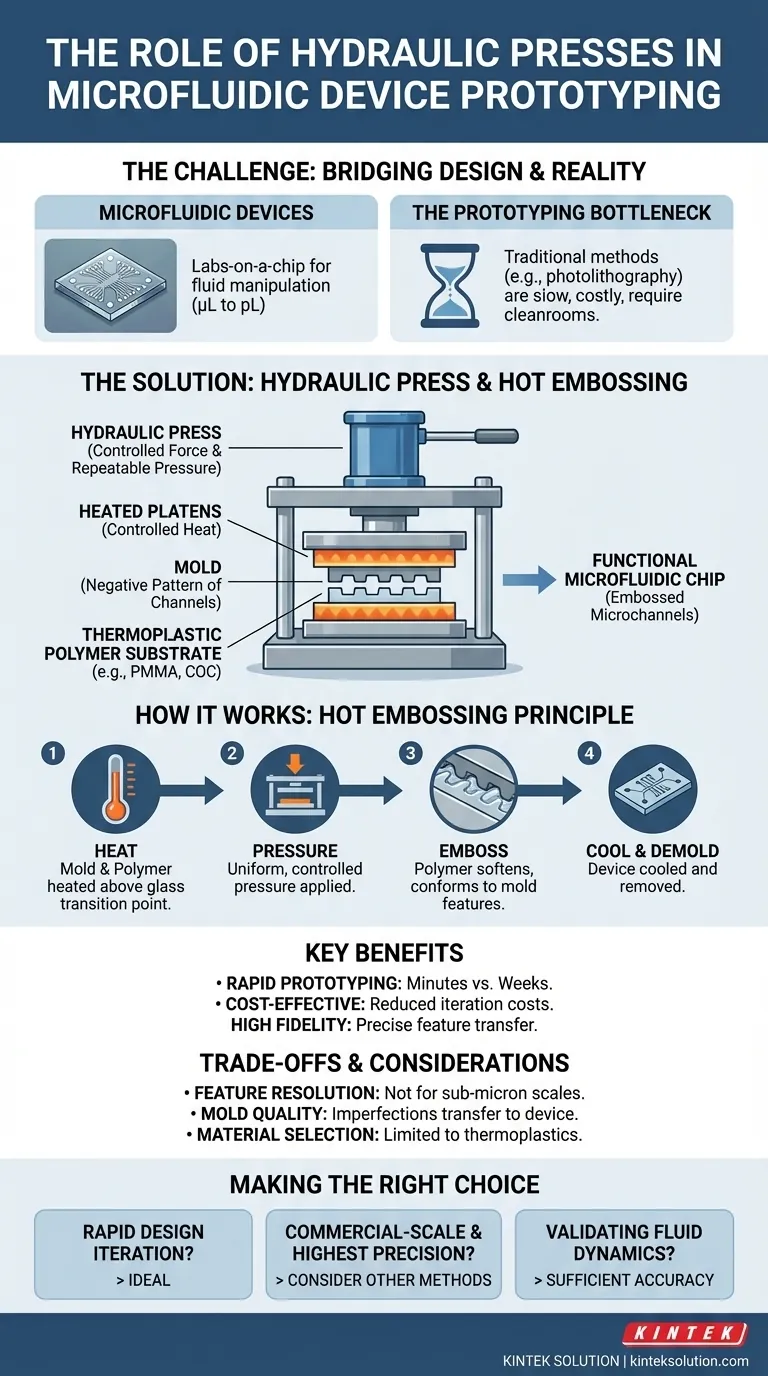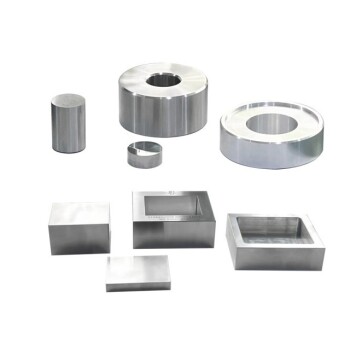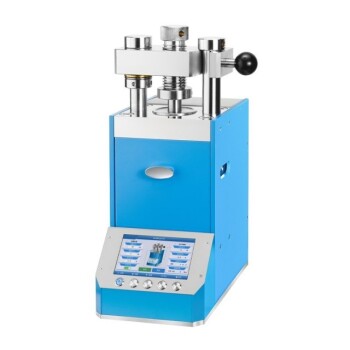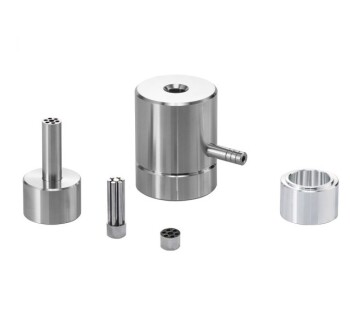In the world of microfluidics, a hydraulic press serves as a powerful tool for rapid and precise prototyping. It enables researchers and engineers to fabricate functional microfluidic chips by embossing microscopic channels into polymer substrates, dramatically reducing the time and cost associated with turning a design into a testable physical device.
The core function of a hydraulic press in this context is not just applying force, but providing highly controlled and repeatable pressure. This precision is what allows for the faithful transfer of micro-scale features from a mold to a polymer, making it an indispensable tool for cost-effective and rapid design iteration.
The Challenge: Bridging Design and Physical Reality
What are Microfluidic Devices?
Microfluidic devices, often called "labs-on-a-chip," are systems that manipulate minuscule volumes of fluid, typically in the microliter to picoliter range. Their functionality depends entirely on the precise geometry of their internal channels and chambers.
The Prototyping Bottleneck
Traditionally, creating these devices involves complex and expensive techniques like photolithography, which require specialized cleanroom facilities. This creates a significant bottleneck, making it slow and costly to test new designs and validate their function.
How a Hydraulic Press Accelerates Innovation
The Principle: Hot Embossing
The primary technique used is hot embossing. A mold, which can be created using methods like 3D printing or micromachining, contains the negative pattern of the desired microchannels. This mold is pressed against a thermoplastic polymer substrate (like PMMA or COC).
The Role of Controlled Pressure
A hydraulic press excels at applying a specific, uniform pressure across the entire surface of the mold. This ensures that the channel depth is consistent and the microscopic features are transferred with high fidelity. This level of control is essential for creating a functional device and is difficult to achieve with simpler methods.
The Role of Controlled Heat
Many lab-grade hydraulic presses are hydraulic hot presses. These machines heat both the mold and the polymer to a precise temperature, just above the polymer's glass transition point. This softens the material, allowing it to conform perfectly to the mold's features under pressure.
The Result: Speed and Accessibility
This process allows a researcher to produce a functional prototype in minutes, right in the lab. It bypasses the need for expensive, outsourced fabrication, enabling rapid cycles of designing, building, and testing.
Understanding the Trade-offs and Considerations
Feature Resolution
While excellent for prototyping, hot embossing with a hydraulic press may not achieve the sub-micron resolutions possible with advanced lithography. Its suitability depends on the specific feature size your application requires.
Mold Quality is Paramount
The final embossed device is only as good as the mold used to create it. Any imperfections, roughness, or design flaws in the mold will be directly transferred to the final prototype.
Material Selection
This method is specifically designed for thermoplastic polymers. It is not suitable for materials like glass or silicon, which require different fabrication techniques.
Making the Right Choice for Your Goal
Before committing to a process, it is critical to align your fabrication method with your primary objective.
- If your primary focus is rapid design iteration: Using a hydraulic press for hot embossing is an ideal, low-cost strategy for quickly testing multiple concepts.
- If your primary focus is commercial-scale production with the highest precision: You will likely need to transition to methods like injection molding or photolithography after validating your design.
- If your primary focus is validating fluid dynamics in a new design: A press-embossed prototype provides more than enough accuracy to confirm that the device functions as intended.
Ultimately, the hydraulic press empowers you to fail faster and innovate smarter, turning a theoretical design into a functional reality with unmatched efficiency.
Summary Table:
| Aspect | Role in Microfluidic Prototyping |
|---|---|
| Function | Applies controlled, repeatable pressure for embossing microchannels into polymer substrates. |
| Technique | Hot embossing using heated molds and thermoplastic polymers like PMMA or COC. |
| Benefits | Rapid prototyping, reduced costs, high fidelity feature transfer, and accessibility in labs. |
| Limitations | Lower resolution than lithography, dependent on mold quality, and limited to thermoplastic materials. |
Ready to streamline your microfluidic prototyping? KINTEK specializes in lab press machines, including automatic, isostatic, and heated hydraulic presses, designed to meet the precise needs of laboratories. Our equipment ensures controlled pressure and heat for reliable, rapid design iterations, helping you accelerate innovation and reduce costs. Contact us today to discover how our solutions can enhance your research and development process!
Visual Guide

Related Products
- Automatic Heated Hydraulic Press Machine with Hot Plates for Laboratory
- Automatic High Temperature Heated Hydraulic Press Machine with Heated Plates for Lab
- Laboratory Hydraulic Press 2T Lab Pellet Press for KBR FTIR
- Laboratory Manual Heated Hydraulic Press Machine with Hot Plates
- Automatic Heated Hydraulic Press Machine with Heated Plates for Laboratory
People Also Ask
- What are the advantages of using a hydraulic heat press? Achieve Precision and Efficiency in Material Processing
- What is a heated hydraulic press and what are its main components? Discover Its Power for Material Processing
- What are the primary applications of a heated hydraulic press in spectroscopy? Enhance Sample Prep for Accurate Analysis
- How is a heated hydraulic press used in material testing and research? Unlock Precision in Material Analysis
- What are the advantages of having a heating element in a hydraulic press? Unlock Precision in Material Processing



















